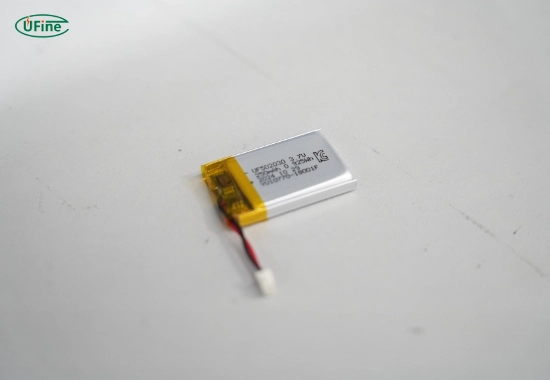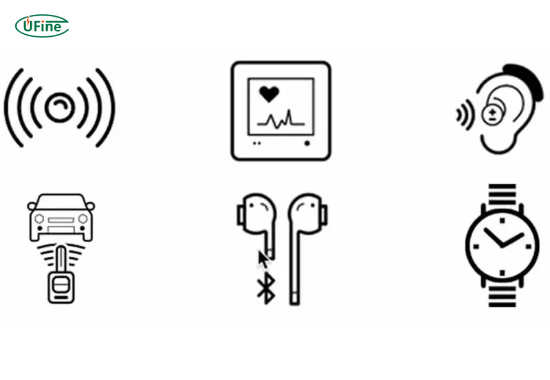
- Part 1. What is a miniature lithium battery and why is it used in wearables?
- Part 2. Key benefits of miniature batteries in wearable devices
- Part 3. Miniature lithium batteries in smartwatches
- Part 4. Miniature lithium batteries in fitness trackers and bands
- Part 5. Miniature lithium batteries in smart rings and micro wearables
- Part 6. Miniature lithium batteries in hearing aids and audio wearables
- Part 7. Miniature lithium batteries in medical wearables
- Part 8. How long do miniature lithium batteries last in wearable tech?
- Part 9. Safety and reliability of miniature lithium batteries in wearables
- Part 10. Future trends in miniature lithium battery technology for wearables
- Part 11. FAQs about miniature battery applications
Miniature lithium batteries in wearables are revolutionizing personal technology. These small but powerful energy sources play a critical role in powering compact electronics like smartwatches, fitness trackers, and medical devices. So, what are the real-world applications of miniature lithium batteries in wearables?
Miniature battery technology is the backbone of modern wearables, enabling lightweight designs, extended battery life, and advanced functionality. In this article, we will dive deep into the top 5 wearable applications for miniature lithium batteries, explore why they are the preferred energy solution, and look at what’s coming next.
Part 1. What is a miniature lithium battery and why is it used in wearables?
A miniature lithium battery is a compact, high-energy power source commonly used in small electronic devices. These batteries are specifically designed to fit inside tiny spaces without sacrificing performance. Their high energy density, long shelf life, and lightweight build make them ideal for wearable electronics.
Wearables are meant to be small, comfortable, and portable. That means they require batteries that can operate efficiently in limited space. Lithium batteries outperform alternatives like alkaline or nickel-based batteries because they are more energy-dense and reliable, especially for devices worn on the body.
Part 2. Key benefits of miniature batteries in wearable devices
Miniature lithium batteries offer several benefits that make them perfect for wearable tech:
- High energy density: Stores more power in a smaller package
- Lightweight: Improves comfort and portability
- Longer battery life: Reduces need for frequent charging
- Rechargeability: Many models can be recharged hundreds of times
- Compact design: Fits into slim, curved, or flexible devices
- Stable output: Delivers consistent energy even in varying temperatures
These features directly support the goals of wearable design, which include continuous monitoring, user comfort, and minimal maintenance.
Part 3. Miniature lithium batteries in smartwatches
Smartwatches are among the most popular wearables, and they rely heavily on miniature lithium battery technology. These devices perform a variety of tasks, including:
- Heart rate monitoring
- Fitness tracking
- Sleep analysis
- GPS navigation
- Smartphone notifications
For all these features to work seamlessly, a small but powerful battery is essential. Most smartwatches use rechargeable lithium-polymer batteries that are thin and lightweight. These batteries can be custom-shaped to fit within the watch’s design. Depending on usage, a fully charged smartwatch can last from one to five days.
Miniature lithium batteries also support quick charging and have a long cycle life, which means they can endure hundreds of recharge cycles without significant degradation.
Part 4. Miniature lithium batteries in fitness trackers and bands
Fitness trackers are designed to be worn all day, every day. They monitor your movement, calories burned, sleep quality, and even stress levels. Because of their continuous use, they require a battery that is both small and long-lasting.
Basic fitness trackers often use coin cell lithium batteries, which can last several months without replacement. More advanced models use rechargeable lithium-ion or lithium-polymer batteries.
These batteries:
- Allow for light and slim form factors
- Provide multiple days of use on a single charge
- Support quick recharging
With battery efficiency improving, modern fitness bands can run for 7 to 14 days on one charge, allowing users to focus on their health and not on charging.
Part 5. Miniature lithium batteries in smart rings and micro wearables
Smart rings are a fast-growing category in wearable technology. These tiny devices are worn like regular rings but can track:
- Sleep patterns
- Heart rate variability
- Temperature
- Blood oxygen levels
- Activity levels
Because of their size, the battery must be ultra-compact, yet powerful enough to last several days. Manufacturers rely on micro lithium-polymer cells that are flexible and energy-dense.
Smart rings typically offer:
- 3 to 7 days of battery life
- Wireless charging capabilities
- Discreet and stylish design
Without miniature lithium batteries, such compact devices would not be possible. The success of smart rings proves how far battery miniaturization has come.
Part 6. Miniature lithium batteries in hearing aids and audio wearables
Modern hearing aids have evolved beyond simple amplifiers. Today’s models include:
- Bluetooth audio streaming
- Adaptive noise cancellation
- Rechargeable systems
Older hearing aids used disposable zinc-air batteries, but miniature lithium-ion batteries are replacing these. These new batteries offer:
- All-day power on a single charge
- Faster recharging
- Consistent performance without volume drops
Some hearing aids come with a charging case that can recharge the device multiple times. This is similar to how wireless earbuds work. Miniature lithium batteries make this possible while keeping the size small and the weight light.
Part 7. Miniature lithium batteries in medical wearables
Medical wearables are used for real-time health monitoring. These devices include:
- Continuous glucose monitors (CGMs)
- Smart ECG patches
- Blood pressure monitors
- Smart thermometers
These devices must be safe, reliable, and long-lasting. Battery failure in medical wearables can lead to inaccurate readings or missed alerts, which is why miniature lithium batteries are the first choice.
Advantages include:
- Long operational life
- Stable voltage for accurate sensor data
- Compact size for discreet wear
Many medical devices are now designed to be worn for 7 to 14 days straight, powered by a single, sealed lithium battery. Disposable and rechargeable options are available depending on the device.
Part 8. How long do miniature lithium batteries last in wearable tech?
The lifespan of a miniature lithium battery depends on several factors:
- Type of device
- Battery capacity
- Usage habits
- Charging frequency
Here’s a general breakdown:
| Wearable Device | Battery Life Per Charge | Battery Lifespan (Rechargeable) |
|---|---|---|
| Smartwatch | 1 to 5 days | 2 to 3 years |
| Fitness Tracker | 7 to 14 days | 2 to 3 years |
| Smart Ring | 3 to 7 days | 1.5 to 2 years |
| Hearing Aid | 12 to 30 hours | 2 to 4 years |
| Medical Wearable | 7 to 14 days (single-use) | N/A |
Rechargeable lithium batteries typically last 300 to 1000 cycles, depending on charging habits and battery quality.
Part 9. Safety and reliability of miniature lithium batteries in wearables
Safety is a top concern when using batteries in devices worn directly against the skin. Miniature lithium batteries are engineered with multiple safety features, including:
- Overcharge protection
- Short-circuit prevention
- Thermal management
- Leak-proof casing
When properly used, these batteries are very safe and reliable. Leading manufacturers follow strict quality standards to ensure that their batteries meet global safety requirements for consumer electronics and medical devices.
Part 10. Future trends in miniature lithium battery technology for wearables
The next generation of miniature battery technology in wearables is already in development. Key innovations include:
- Solid-state lithium batteries: Safer and longer-lasting than current lithium-ion models
- Flexible batteries: Can bend and twist without damage, ideal for smart patches and e-textiles
- Energy harvesting wearables: Devices powered by body heat, motion, or solar energy
- Faster wireless charging: Improving convenience and reducing downtime
As wearables become more advanced, the demand for smaller, smarter, and more efficient batteries will continue to grow.
Part 11. FAQs about miniature battery applications
What is the smallest miniature lithium battery used in wearable devices?
The smallest miniature lithium batteries are micro coin cells and ultra-thin lithium polymer cells, with diameters as small as 3 millimeters. These are used in smart rings, medical patches, and micro hearing aids.
Can all miniature lithium batteries be recharged?
No. Some miniature lithium batteries, like coin cells, are designed for single use, while others, like lithium-polymer and lithium-ion types, are rechargeable and built for hundreds of cycles.
How do I maintain battery life in my wearable device?
To extend battery life:
- Avoid overcharging
- Keep the device cool
- Use power-saving modes
- Update firmware regularly
Smart usage habits can increase both daily runtime and long-term battery health.
Are lithium batteries in wearables safe for children and elderly users?
Yes, as long as the device is made by a reputable brand and used correctly. Many devices include tamper-proof battery housings and FDA-certified health features.
Will future wearables eliminate the need for batteries?
Some experimental wearables use energy harvesting from body movement or heat, but for now, most devices still rely on miniature lithium batteries for consistent and dependable power.
Related Tags:
More Articles

Is It Bad to Fully Discharge a Lithium Ion Battery?
Discover what happens if a lithium battery is fully discharged and how to safely recharge 12V batteries to prevent permanent damage.
Does a Higher mAh Battery Last Longer?
Does a higher mAh battery really last longer? Learn what mAh means, real battery life in hours, replacement safety (4000 vs 5000mAh), and real examples.
Exploring the Lithium Ion Battery Fire Temperature
Discover the lithium-ion battery fire temperature and learn how to stay safe. Get essential tips to prevent battery fires and protect your devices today.
The Ultimate Guide to 6s Lipo Batteries
A beginner-friendly guide to 6S LiPo batteries. Understand voltage, capacity, charging tips, safety rules, and real-world applications.
What is the NCMA battery? What is the difference between it and the NMC battery? Which one is better? This article will answer your questions.




